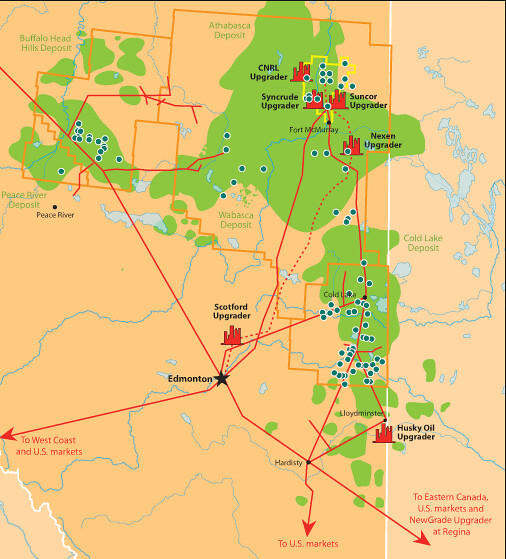From: Daily Kos
by
What's going to be in the Keystone XL pipeline? Heavy Canadian Crude
from the Tar Sands in Alberta. Here is a list of industry names for it:
Access Western Blend, Borealis Heavy Blend, Christine Dilbit Blend, Cold Lake, Heavy Sour Dilbit, Peace River Heavy, Seal Heavy Blend, Statoil Cheecham Blend, Wabasca Heavy Blend, Western Canada Select, . All the sites on the map are producing tar sands bitumen. In some areas it is strip mined and in others it is extracted by steam. Let me be clear, it is DILBIT, diluted bitumen from Alberta Canada's tar sands ecocide. It's the dirtiest crude in the world, full of muck, sand and extra chemicals. The exact formulae are proprietary secrets but you can find a list of what might be in it here: under Heavy Sour Dilbit.
After the latest dilbit disaster in Mayflower, AR, a spokesperson for Exxon tells KARK, Arkansas' news Station that the spill is "Wabasca Crude oil." It is not oil, it is dilbit. As one writer puts it, "it's like calling all tomatoes, 'ketchup'." It has a long way to go in the refineries before becoming oil.
Here is a map that shows where dilbit comes from in various places in northern Alberta. On the lower right is Hardisty, AB where the Keystone XL begins.
Access Western Blend, Borealis Heavy Blend, Christine Dilbit Blend, Cold Lake, Heavy Sour Dilbit, Peace River Heavy, Seal Heavy Blend, Statoil Cheecham Blend, Wabasca Heavy Blend, Western Canada Select, . All the sites on the map are producing tar sands bitumen. In some areas it is strip mined and in others it is extracted by steam. Let me be clear, it is DILBIT, diluted bitumen from Alberta Canada's tar sands ecocide. It's the dirtiest crude in the world, full of muck, sand and extra chemicals. The exact formulae are proprietary secrets but you can find a list of what might be in it here: under Heavy Sour Dilbit.
After the latest dilbit disaster in Mayflower, AR, a spokesperson for Exxon tells KARK, Arkansas' news Station that the spill is "Wabasca Crude oil." It is not oil, it is dilbit. As one writer puts it, "it's like calling all tomatoes, 'ketchup'." It has a long way to go in the refineries before becoming oil.
Here is a map that shows where dilbit comes from in various places in northern Alberta. On the lower right is Hardisty, AB where the Keystone XL begins.
Northern Alberta Canada, Map from Center for Energy
Crude from all these sites is not conventional oil, it is Tar Sands
Bitumen, and in the pipeline in its diluted form, it is DILBIT. That's
what is going to be in the 36" wide, 1,703 miles of the Keystone XL
pipeline (KXL). This pipeline will cross the US landscape from north to
south with a capacity of 900,000 barrels per day. MORE

No comments:
Post a Comment